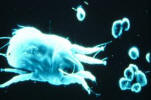Home
A Broad Introduction
Allergy Concepts
Food Issues
Asthma
Rhinitis & Hay Fever
Eczema
Children & Infants
Allergy to Animals
Finding Answers



|
 Introduction Introduction
From the moment of birth babies must adapt to independent life, and
breast milk gives them the best start, unless they are reacting to
traces of foods from the mother’s diet, such as cow’s milk or eggs.
This is rare, but obviously traces of any food or drug that mother
eats must appear in her milk. Unfortunately conflicting opinions may
be given by nursing staff regarding infant feeding. Giving a bottle
just after birth ‘to give mother a rest’ may still occur, being
unaware that this can sensitise the baby to cow's milk before the
first breast feed. As a result acute problems may occur without
warning when changed from purely breast milk to cow's milk formula.
 Asthma and rhinitis in children is more dominantly allergic in
causation than later in life, hence an in-depth allergy
investigation is more likely to be helpful for children.
Unfortunately very few children’s specialists in the UK are
interested or knowledgeable about allergy. Asthma is the commonest
cause of children being admitted to hospital, but they are usually
rescued and sent home again in a few days without any attempt to
find the cause, which is often to be found in the home environment
or in the food. Asthma and rhinitis in children is more dominantly allergic in
causation than later in life, hence an in-depth allergy
investigation is more likely to be helpful for children.
Unfortunately very few children’s specialists in the UK are
interested or knowledgeable about allergy. Asthma is the commonest
cause of children being admitted to hospital, but they are usually
rescued and sent home again in a few days without any attempt to
find the cause, which is often to be found in the home environment
or in the food.
Seasonal rhinitis, or “Hay Fever” is caused by allergy to grass
pollen which gets in the air in June and July, and less often tree
pollens in the spring. There have been great improvements in
antihistamine drugs which seldom cause sleepiness now, and steroid
sprays are helpful if started at the beginning of the season and
used regularly every day until the end. Unfortunately important
examinations in England (not in Scotland) are held in the hay fever
season and results may be affected either by the hay fever or by the
sedative effects of antihistamines obtainable over the counter. In bad cases which cannot be controlled with the
usual drugs oral steroids for a few days are fully justifiable, are
guaranteed to give certain relief, and hence give no excuse for
failure in examinations. There is no reason to fear side-effects
from a few days on oral steroids.

 Chronic
Allergic Rhinitis—a Neglected Affliction Chronic
Allergic Rhinitis—a Neglected Affliction
Chronic Rhinitis, with a chronically blocked and runny nose and
sneezing, is very common in children but often not recognised as due
to allergy, and simply endured and ignored. It is common to have
asthma as well, but the nasal problems often cause more disturbance
to the quality of life than the asthma by causing nasal blockage,
tendency to sinus infections, snoring, mouth breathing, glue ears
from blockage of the Eustachian tubes, and even orthodontic
problems. If the cause is in the environment or the food repeated
insertion of grommets gives only temporary relief. Nasal allergy
cannot be removed surgically, yet surgery may be advised without benefit. Chronic perennial rhinitis is easily
diagnosed because the sufferers are often sniffing, rub the nose
upwards in a characteristic gesture, often have a crease across the
tip of the nose, and heavy shadows under the eyes.
The photos below illustrate the characteristic appearances of
children with allergy problems. Very few doctors are familiar with
these obvious signs of nasal allergy which can have quite serious
effects on health. The crease across the nose is one of the
commonest signs of allergy and is due to rubbing the nose upwards to
ease the itching, a gesture which is called the “allergic salute” in
the USA. One of the main advocates of this ‘spot diagnosis’ of
allergy was the late Dr Meyer B Marks of Miami, Florida, who
published a monograph on the effects of nasal allergy illustrated
with similar pictures. I always remember a small boy about thirty
years ago with chronic rhinitis and an obvious nasal crease who took
my comments so seriously that he went round his class at school and
reported at his next visit that 10 out of thirty children also had
nasal creases! I wonder what the count would be now, and if he went
for a medical career!
|
|
|
|
|
|
Examples of the heavy shadows under the eyes which are a
common feature of nasal allergy
|
| |
|
|
|
|
|
|
|
Examples of the allergic salute and how the nasal crease
is created
|
| |
|
|
|
|
|
|
High
palate and Malformed teeth
|
sniffing to ease itch
|
Extra
folds on the eyelids are a sign of eczema
|

 The Importance of Finding the Causes of Childhood Asthma The Importance of Finding the Causes of Childhood Asthma
The prevalence of Asthma continues to increase year on year, and
allergies are more important as a cause of asthma and eczema in
children than in adults. If asthma is allowed to become chronic
permanent changes will eventually become established by remodelling
of the bronchial tubes whereby the walls become thicker and stiffer.
Even if the cause can be found and completely avoided after an
asthmatic child has grown up into an asthmatic adult it will be a
long time before the irritability of the bronchi and the reaction to
the allergen which triggered the asthma attacks will cease and the
‘remodelling’ reverts to normal. Unfortunately this logical approach
is seldom followed in the UK today, where it is uncommon for any
investigation to find and perhaps eliminate the cause is undertaken,
and treatment depends almost entirely on drugs.
It is surprising how few Paediatricians, who specialise in children,
appear interested in finding out why their hospital wards are
crowded with wheezing children. Asthmatic children often do not get
better spontaneously at age seven or fourteen years, yet parents may
still be assured that they will do so. Even those children who
lose their asthma in adolescence quite often relapse in later life.
Even when asthma is effectively suppressed with drugs these children
are still becoming permanently programmed to respond to common
allergens such as dust mite. This is because the allergic reactions
in the bronchi are only suppressed, not stopped altogether.. This
also means that even if these allergy victims are properly
investigated and their allergies sorted out after they have grown up
into adults the prospect of really significant improvement is less
than it would have been if they had had proper investigation and
treatment when they were young and completely reversible. This
suggests that in future the numbers of established chronic
asthmatics will increase, unless the allergic factor is properly
dealt with in childhood, not in adulthood when it may be too late.

 Chest Deformities Caused by Asthma Chest Deformities Caused by Asthma
Chronic asthma in children can produce deformities because the bony
frame of the growing chest is soft and hence more easily distorted.
The gross deformities shown have become uncommon since the
introduction of effective treatment, particularly inhaled steroids,
and most were seen many years ago. These changes are often
reversible if effective treatment such as inhaled steroids is
introduced before the growth spurt in adolescence.
|
|
|
 |
 |
|
Examples of the effects of chronic uncontrolled asthma
on the shape of the chest in teenagers
|
| |

 Allergies may change as time goes by Allergies may change as time goes by
The affected part of the body can also change with time. For example
a baby could be intolerant or allergic to milk or egg causing eczema
or colic which fades out, but may often be replaced by rhinitis
and/or asthma, or all these problems may persist indefinitely. This
is known as the ‘Allergic March’ which will seldom stop unless the
causative allergies are identified. Advice to await growing out if
it is unreliable, as the more severe the asthma in childhood the
more likely that it will persist lifelong, and even when the asthma
goes into remission it quite often returns in later life. There is
evidence, from trials in Europe and the USA, that treating the seasonal
hay fever with desensitisation seems to prevent the child acquiring
other allergies in the early years, but of course British children
are denied this chance.
Dangerous allergies causing anaphylactic shock in children are most
commonly caused by peanuts or other nuts eaten accidentally. It is
essential that these children always carry two special Epipen or
Anapen syringes containing adrenaline, (Epinephrine in USA) and that
the school teacher is willing to give the injection in an emergency
if the child is too young to do this themselves. There can be
problems in arranging for adequate precautions regarding diet at
school, and teachers responsibility for dealing with a possible
emergency.
It is obviously very important to find out exactly which foods must
be strictly avoided, but finding a clinic in the UK where this can
be investigated may be difficult. It is also potentially life-saving
to wear a ‘Medic-Alert’ bracelet to warn doctors of a dangerous
allergy, especially to drugs they might inject, especially If the
patient is unable to speak. Information is available at
www.medicalert.org.uk
It is also most important to join the Anaphylaxis Campaign at
www.anaphylaxis.org because their newsletters are very
informative and ensure that the patient is aware of the latest
developments and new dangers, such as lupin flour. In my opinion the
membership fee for both these organisations should be taken care of
by the NHS because their service is so inadequate. |

